The 2022 BMW i4 M50 is the first fully electric performance vehicle from BMW’s M division. Essentially a battery-powered version of the 4 Series Gran Coupe, this vehicle offers explosive acceleration, lots of great tech and a few compromises you might not expect.
A paint job that POPS
Before getting to this vehicle’s driving dynamics, features and charging performance, let’s take a gander at the exterior. Other than the gigantic faux grille that brings to mind flared nostrils, the first thing you’ll probably notice about this example is the paint. It’s a stunning matte-finished color called Frozen Portimão Blue Metallic, and it is worth every single penny of the $3,600 BMW charges for it.
Beyond that beautiful blue, this car is also fitted with the $2,800 M Carbon Exterior Package, which includes a special trunk lid spoiler as well as unique mirror caps and bumper trim. We also have the $2,500 High Performance Package that provides 20-inch wheels, which look great but savage the range — more on that a little later when we compare this i4 M50 to some rival vehicles.

This BMW’s exterior styling is a bit polarizing — not everyone will love that gigantic grille — but one feature I find far more troubling is the design of the exterior door handles. Instead of pop-out grips or electrically operated switches found on other EVs, you open these doors using old-school flipper-style handles like cars had back in the 1990s. These should be more aerodynamic than pull-type levers, but this design is not finger friendly. My hand nearly slips off every time I open a door.
SEE ALSO: Dodge’s all-electric muscle car will have a transmission with ‘more than two speeds,’ ride on STLA Large platform
Like on coupes and convertibles, you get frameless windows on the i4. This car also has a liftback rear end that opens nice and wide so you can access the adequately sized 10-cubic-foot luggage compartment. Unfortunately, there’s no front trunk, just a whole bunch of plastic covers hiding powertrain components.
A good interior and tech
There are plenty of plastics inside the i4 M50, too. Even though nothing is cheap or feels flimsy, this cabin isn’t quite as premium as what you get from Audi, Mercedes-Benz or even Genesis these days. The materials are just a little more mainstream.
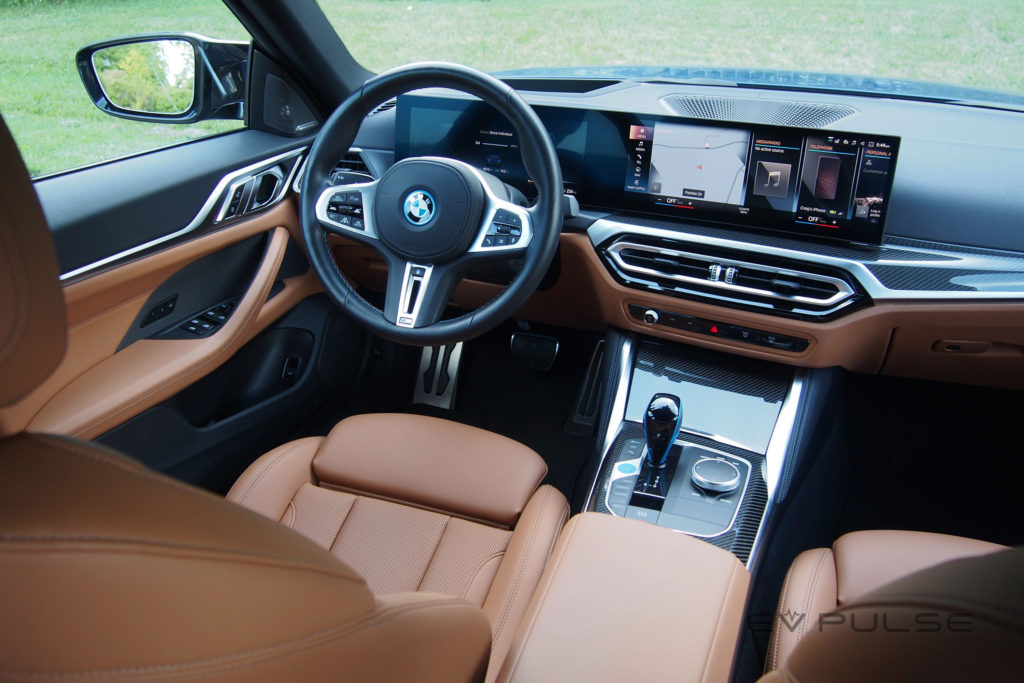
This car features BMW’s SensaTec artificial leather that feels nice and looks great, especially in the available cognac color. If you want the real McCoy, however, for $1,500 more you can get high-end Vernasca leather, which is offered in a variety of hues, the usual suspects like gray, black and tan plus one called Tacora Red.
The i4’s front seats get the job done; they’re supportive but otherwise nothing to write home about. The rear bench is a bit tight for adult passengers. The aft door openings are also quite narrow, which makes getting in or out a challenge plus headroom is in short supply.
The i4 features a 12.3-inch digital instrument cluster and a 14.9-inch central touch screen. Mounted in a single, curved housing, both panels are gorgeous, crisp and clear. BMW’s iDrive 8 infotainment system lives in the larger of those two screens and, unfortunately, has a steep learning curve. This multimedia array is colorful and super responsive, but it takes a while to learn where everything is and how it works, so spend a few minutes poking around before hitting the road.
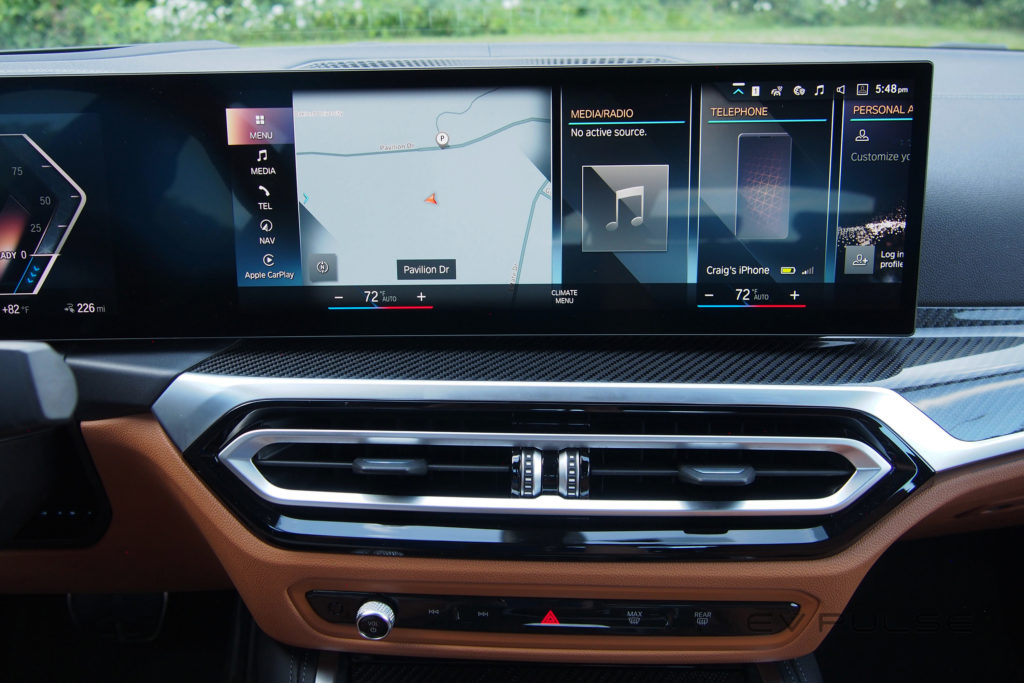
Simplifying things slightly, Android Auto and Apple CarPlay are standard, and both smartphone-mirroring systems can connect to this BMW wirelessly. We also have a wireless phone charger, a lovely head-up display and a rockin’ Harman Kardon sound system. A super-sharp 360-degree camera system with a 3D view and automatic parking functionality makes docking this vessel just a little easier. All these items are either stand-alone options or bundled in an extra-charge package.
Two trims, lots of range estimates
Two versions of this BMW are offered: the i4 eDrive40 and i4 M50. The former is rear-wheel drive, while the latter comes standard with all-wheel drive. Naturally, range and output vary significantly between these two models
CHECK THIS OUT: Toyota exploring portable power utilizing hydrogen, benefits huge
The i4 eDrive 40 can go up to 301 miles between charges when fitted with 18-inch wheels. If you opt for the available 19s, that figure drops to a less impressive, though still decent, 282. Those figures are appreciably better than what the i4 M50 can muster. Fitted with 19-inchers, this car offers an EPA-estimated 270 miles of range, but if you grab the 20s, like this test car has, that figure drops to just 227, which is not terribly impressive. This goes to show you the huge impact wheels and tires have on vehicle efficiency.
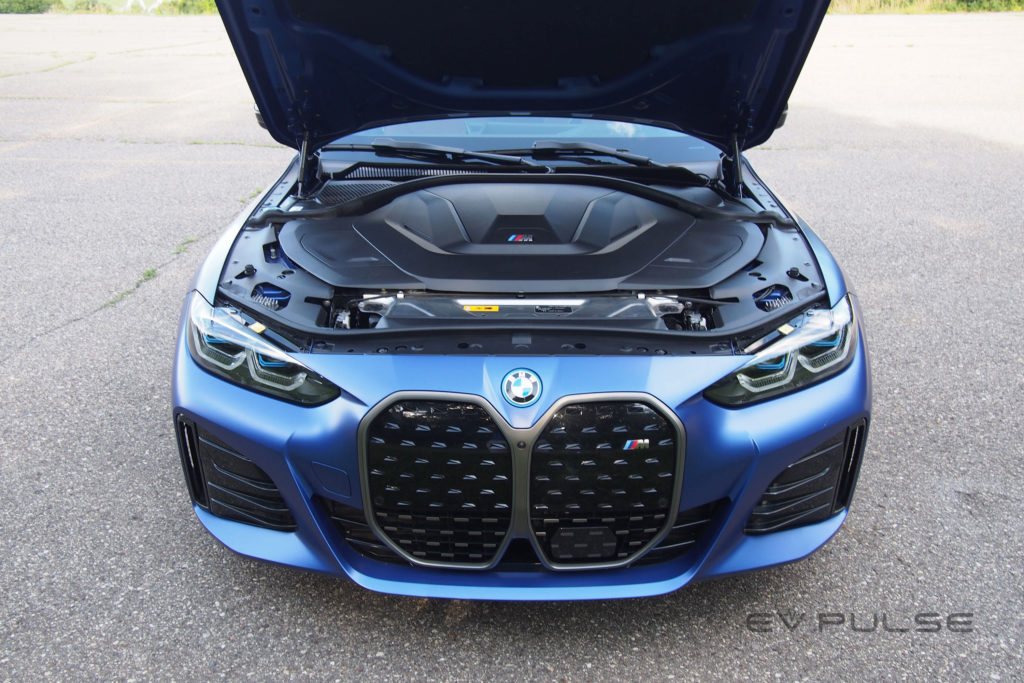
When it comes to output, the base i4’s single rear motor provides a more-than-respectable 335 horsepower. In comparison, the M variant cranks out up to 536 horses, with its front dynamo providing 255 and the rear 308. It’s a similar story with torque. The lesser car gives you 317 pound-feet of twist to play with, while the i4 M50 is graced with up to 586! In both measures, that’s more giddy-up a BMW M3 Competition provides (503 hp and 479 pound-feet).
Despite their range and performance differences, both version of the i4 feature the same lithium-ion battery pack with 83.9 kWh of gross capacity. This electron reservoir can Level 2 charge at 11 kW, which is enough to go from empty to full in around 8.3 hours, which is pretty standard. Where the i4 really shines, however, is in DC fast charging, because it can absorb energy at a rate of 200 kW. That’s not an industry-leading speed, but it’s still impressive.
Putting the ‘M’ in ‘performance’
The i4 M50 is so quick off the line, it hits so hard, I practically expect the CV joints to explode like pipe bombs. The thing just goes ka-boom when you jump on the accelerator, it’s almost violent. BMW estimates the car can go from 0 to 60 mph in just 3.7 seconds, and it feels every bit that quick.
Supporting a not-insubstantial 5,018-pound curb weight is an adaptive suspension system with adjustable dampers and self-leveling rear air shocks. This combo provides a ride that is both settled over large undulations and smooth when the going gets rough. This Bimmer always feels a little husky — mostly because it is — but those large, 20-inch wheels that do so much to reduce the i4 M50’s range do not degrade the ride quality very much at all. This car is always comfortable and controlled.
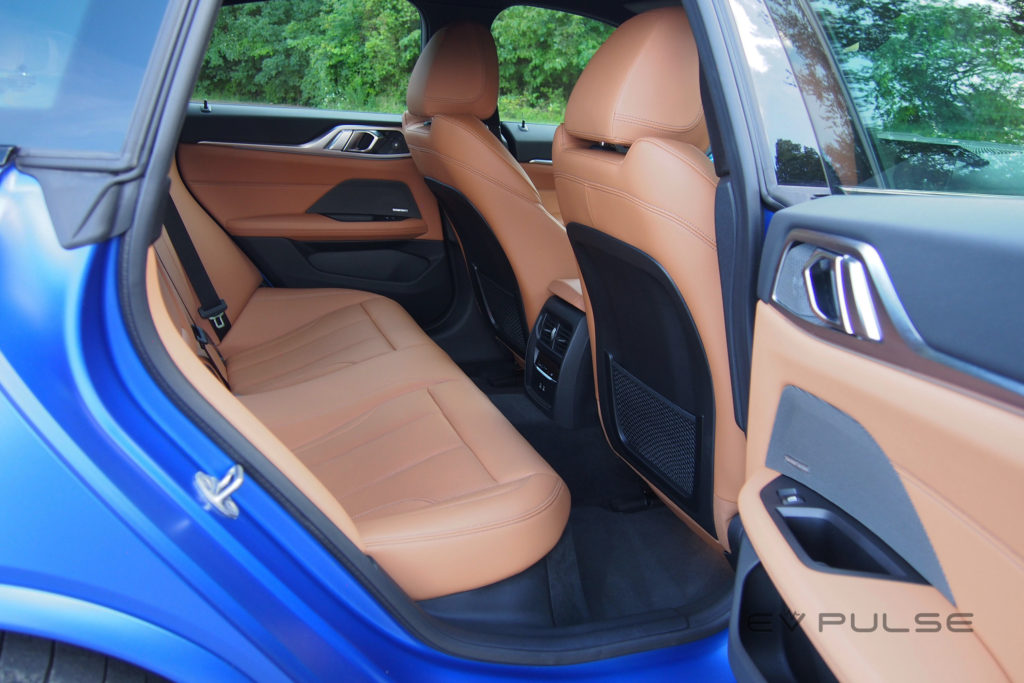
All-wheel drive is standard in the i4 M50, but in normal use the rear motor does all the work until there’s wheel slip or lots of lateral acceleration. Then the front unit comes into play. When it does engage, it’s completely transparent.
The i4 M50 is competent, but unquestionably its biggest dynamic weakness is the steering. This car is properly quick and it rides well, but the wheel feels ho-hum, there’s no liveliness to it. The steering is no more engaging than what you get in, say, a Toyota bZ4X, which is a disappointment for an M-tuned vehicle. This car also tends to wander a little, even on straight roads.
For a little more engagement, there’s a feature called “Iconic Sounds” that mimics the noises an internal-combustion powertrain makes. I prefer leaving this off. Synthesized noises aren’t my thing, plus I appreciate that EVs are super quiet and smooth.
i4 M50 vs. the competition
Right now, there are only two vehicles available that really compete with the i4 M50, though neither is a perfect fit. There’s the Porsche Taycan 4S with the Performance Battery Plus and Tesla’s Model 3 Performance All-Wheel Drive.
In the range department, the i4 M50 with 20-inch wheels is EPA rated at 227 miles and the Taycan 4S with the Performance Battery Plus can go the exact same distance between charges. The Tesla Model 3 Performance trounces both of those cars with an EPA-estimated range of 315 miles. If you regularly drive long distances, get the Tesla.
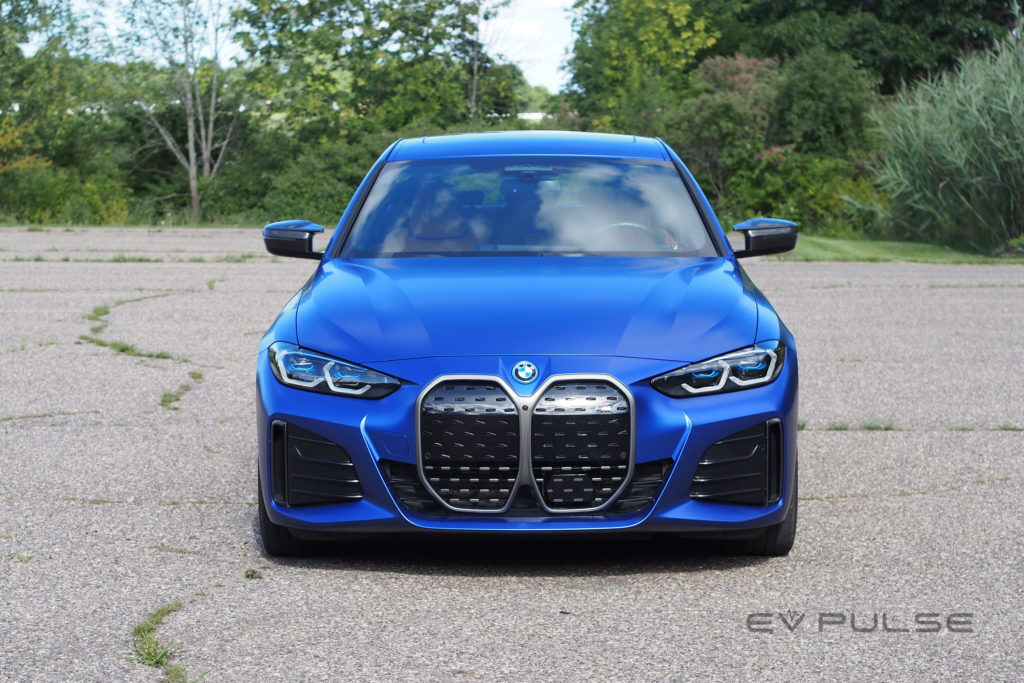
When it comes to DC fast charging, the BMW maxes out at an impressive 200 kW. With its optional battery, the Porsche can absorb energy at a stellar 270 kW. As for the Tesla, it tops out at an estimated 250, which is also superb.
DON’T MISS IT: 2022 Volvo C40 Recharge review: Fashionable, functional and surprisingly fast
Finally, let’s talk pricing. The i4 M50 starts at around $68,000 including $995 in destination fees, which is actually kind of amazing given that, one, this is a BMW and two, it goes like absolute hell. Not surprisingly, the Taycan 4S with the Performance Battery Plus is NOT as good a value, nowhere close. This car is available from about 113 grand, though it goes up, Up, UP from there because this is a Porsche and they love charging you for every little thing. Conversely, the value leader in this group is the Tesla Model 3, which can be yours from about $64,190 including $1,200 for delivery.
The verdict
With a smattering of options like fancy paint as well as the driver assistance, premium and high-performance packages, this i4 M50 checks out for about $83,000. That’s not cheap, but it’s still a good value in the premium EV market, far better than a Taycan 4S.
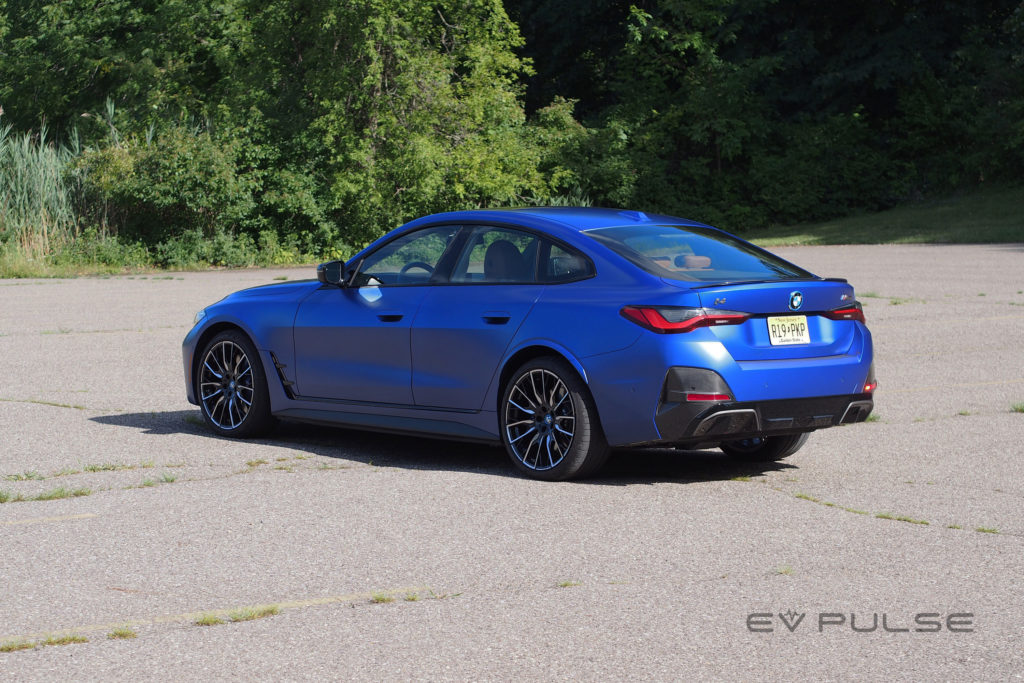
Aside from its staggering straight-line speed, the i4 M50, unfortunately, is not much of a driver’s car, meaning it isn’t necessarily a great BMW, let alone one tuned by M. Still, thanks to its quick charging, reasonable starting price and good range when fitted with smaller wheels, this is at least a very good premium EV.
At a glance
- Year: 2022
- Make: BMW
- Model: i4
- Trim: M50
- Type: 4-door luxury coupe
- Horsepower: 536
- Torque: 586
- kWh/100 miles: 42
- MPGe ratings (city/highway/combined): 79/80/80
- Range: 227 miles
- Pros: Rapid acceleration, beautiful matte-finished paint job, speedy iDrive 8 infotainment system, wireless smartphone mirroring, a good value
- Cons: Learning curve for iDrive 8, odd exterior door handles, tight rear seat, range is a little low, dull driving dynamics
- Estimated base price: $68,295 (including $995 in destination fees)
- As-tested price: $82,820 (including $995 in destination fees)
